FOOD SAFETY SYMPOSIUM AND GLOBAL FOOD SAFETY CURRICULUM
Authors: Loretta Mugo, George Abong’, Cecilia Wanjuu, Joseph Mwaniki, Josephat Njenga and Judith Meech
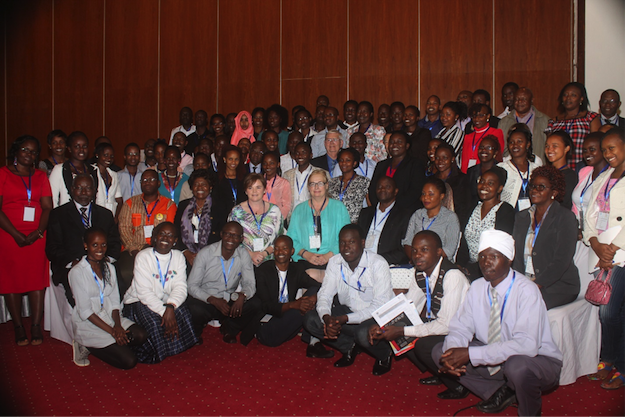
19TH JANUARY 2017
Introduction
A one day food safety symposium was held at the Laico Regency, Nairobi on the 19th of January 2017. The symposium was organized by Food Science and Technology Platform of Kenya (FoSTeP-K) with support from International Union of Food Science and Technology (IUFoST) and was attended by 106 participants including local and international partners (at least 12 countries being represented), who are keen to form strong linkages with African countries even as the continent races to improve its food safety systems. The symposium was chaired by Dr. George Abong’, a lecturer from the Department of Food Science, Nutrition and Technology, University of Nairobi and the current chair of the FoSTeP-K and was officially opened by Judith Meech (IUFoST Secretary General, Canada), Hon. Prof. Ruth Oniang’o (IAFOST President and FoSTeP-K Patron, Kenya) and Dr. Cheikh Ndiaye (Consultant, Senegal). Interactive sessions with seasoned food safety experts included key aspects such as: current food safety scenario in Kenya and Uganda (Prof. Archileo Kaaya); Misconceptions and misinformation on Food Additives with special emphasis on salt (Dr. Ing. Donald Mercer, Canada); Role of Food Industries in assuring Food Safety in Kenya, Mr. Kevin Ouma (Tropical Heat Ltd) and Mr. Alex Ngahu (Nestle Kenya Ltd); Food Safety Concerns of GMOs, Prof. T. Mutui of National Biosafety Authority of Kenya; European labelling approaches to promote consumer education and selection of packaged foods, Dr. Pamela Byrne (Chief Executive Officer, Food Safety Authority of Ireland (FSAI); Contribution of African Higher education to food safety, Prof. Anakalo Shitandi, Kisii University, Kenya. Group discussions featured a number of topics in the area of Food Science and the Global Food Safety Curriculum being developed by IUFoST with support from the World Bank. The department of Food Science, Nutrition and Technology University of Nairobi had great interest especially on the curriculum development. They were represented by Chairman of the department and other staff members.
Opening Remarks
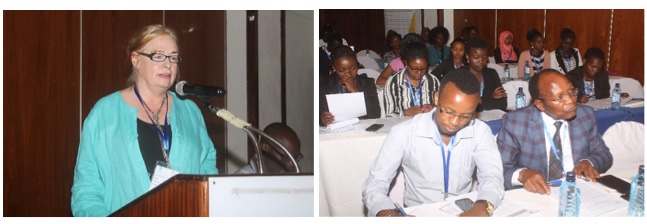
Judith Meech giving her opening remarks as other participants follow the proceedings
Officials from IUFoST were represented during the symposium led by their Secretary General Judith Meech who gave the opening remarks after an introductory session where all the delegates had the opportunity to introduce themselves. Judith expounded on the role of IUFoST to the global food industry. The organization works closely with WHO and FAO where they play a consultative role in the food safety value chain- processing to marketing and consumption. IUFoST is also involved in educating and training professionals through International Academy of Food Science and Technology (IAFoST) whose current president is Prof. Ruth Oniang’o. According to Judith, IUFoST is also greatly involved in improvement of scientific communication to separate science from fiction in matters of food safety. She was very excited to be in attendance and congratulated the food professionals for the great work they are doing in the industry.

Prof. Oniang’o, Dr. Ndiaye and Dr. Abong’ giving their opening remarks at the symposium
Prof. Ruth Oniang’o in her remarks emphasized on the importance of staying relevant in the industry. “If I cannot find your name on the google in relation to scholarly work in food and nutrition and related fields then you are not performing your role as a scientist”, she said. As the president of IAFoST and the Founder and Editor-in-Chief of The Food, Agriculture, Nutrition and Development (AJFAND), she encouraged the young scientists present to leave a lasting mark in their profession and to interact with the experienced speakers and delegates in attendance. As the patron of the FoSTeP-K, she acknowledged the presence of IUFoST members, Don Mercer and Judith Meech as well as other participants. She also acknowledged the private sector and food industries, and the regulatory bodies and requested the speakers to mentor the young and up-coming scientists.
According to Dr. Cheikh Ndiaye, the symposium was a timely event due to recent food safety and security concerns in Africa ranging from food borne illnesses and pandemics, wars, calamities, safety of street foods, new and emerging technologies and substandard foods and food losses and regulatory concerns especially for street foods. Dr. Ndiaye is the current executive director of the Food Information Council for Africa, an organization that aims at bridging the gap between Science and Communication. They work to translate scientific research into clear and useful information for opinion leaders, industries, and consumers in Africa. He emphasized on the need to understand food safety and to consult and communicate. He encouraged participants to use the event as a platform for sharing information and an experience to promote food safety for effectiveness and efficiency in control of potential Food Safety risks and public health concerns. Dr. Ndiaye also called to attention the need to improve food safety and security for a healthy and productive lives. He acknowledged participation of experts and technicians whose commitment and contribution has greatly improved regional food safety and thanked everyone who made it possible to organize the one-day workshop.
Overview of Food safety situation in East Africa

Participants keenly following Prof. Kaaya’s presentation during the symposium
Prof. Archileo Kaaya from Makerere University, Uganda presented on the state of food safety in Uganda at a time when officials were tackling a bird flu outbreak in the country. He spoke of Food safety as a relationship cycle-agriculture leads to food, food leads to dietary intake/nourishment which leads to health. But the one factor that holds the cycle together is food safety. He highlighted the burden of food-borne illnesses in the country whereby amid other challenges in the food sector, they are faced with frequent outbreaks of Pathogen related food borne diseases causing, acute diarrhea, botulism, brucellosis (milk), Hepatitis E, typhoid, dysentery, cholera. Chemical and toxins related illnesses brought about by aflatoxin, methanol (illicit brews), lead and cyanide in cassava are not new. He highlighted that the National Food Control System (NFCS) is responsible to protect consumers from Public Health concerns and foodborne diseases, protect consumers from adulteration and promote economic development in the food system through the six pillars:
1. Food Laws and regulation
2. Food Control management
3. Inspection services
4. Lab services,
5. Food monitoring and epidemiology and
6. Training and capacity building
The NFCS is a multi-agency association working through the combined effort of diverse government ministries, private sector and consumers. Ministries involved are such as the Ministries of health, Agriculture livestock and fisheries, Trade, water and environment and local government.
The disadvantage, however, according to Prof Kaaya is Inadequate coordination hence duplication of roles, fragmentation, outdated laws and insufficient capacity in scientific data generation. For this reason the government of Uganda is drafting the National Food and Drug Authority policy- 2017 that will be out in February 2017. This will have all the food laws and Acts of Uganda. This food safety bill-2017 among other interventions will go a long way in improving the state of food safety in Uganda emphasized.
The Role of Industry in Assuring Food Safety

Mr. Ouma and Mr. Ngahu giving their presentations at the symposium
Private sector stakeholders were not left out of the discussion either. Kelvin Ouma from Tropical Heat Ltd (formally Deepa Industries) and Alex Ngahu from Nestle Kenya Ltd spoke extensively on the role of industry in assuring food safety. Tropical Heat Ltd, a leading snack and spices company in Kenya employ a farm to fork approach whereby they have food safety trainers and inspectors through the entire food chain. They put emphasis on the quality of potatoes, peanuts, spices and corn oil as their raw materials. They train spice and potato farmers on Good Agricultural practices which have a great impact of the quality and safety of raw materials that they receive. As an exporter to 14 countries including the US and the UK, Tropical Heat called for the need to harmonize food safety standards which are the main hindrances in food exports.
Alex Ngahu, Nestle’s head of Food Safety in Equatorial Africa indicated their role in food safety. Food safety is extremely important which is why Nestle is FSSC 22000 certified, the highest food safety certification currently. Alex highlighted the various hazards in food processing, the need for a farm to fork approach in hazard analysis and risk assessment, Prerequisite programs and a HACCP system to prevent food safety related cases such as what happened to Nestle’s Maggi noodles in India.
Food Additives: Misconceptions and Misinformation
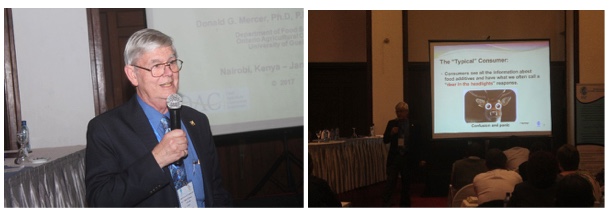
Dr. Mercer giving an elaborate presentation on additive misconceptions
‘We ultimately do what we do as food safety experts for the benefit of the consumer. Therefore when the consumer is misinformed or not informed at all our goals are not achieved.’ Donald Mercer. According to Donald Mercer, an associate Professor of Food Science in Canada and a fellow of IAFoST, a consumer’s scientific literacy levels can be equated to that of an 8th grade Student and this affects their perception with regards to food additives. Information, depending on how it is disseminated may create confusion and panic due to lack of thought or impression as a result of selective hearing and vision on the consumers’ part. Also due to influence by celebrities, tabloids and news sources.
Dr. Mercer used an example of salt as a food additive and based his presentation on an article in the internet from a Canadian food blogger about table salt vs Himalayan pink salt. The common misconception here being that Himalayan pink salt is better than table salt when in actual fact it’s not. Consumers go for the easy to understand information that is in plenty in the internet rather than technical scientific facts. It is therefore imperative that those people giving information are well informed in order to guide the consumer appropriately.
Food Safety concerns of GMOs
The speaker of the day was Prof. T. Mutui of the National Biosafety Authority of Kenya (NBA). The National Biosafety Authority ensures safe development, transfer and use of GMOs in Kenya. It regulates research and approves commercial facilities for GMO production and Promotes awareness in the country. It is the mandate of the biosafety authority to carry out Food safety testing of GM foods. This exercise is governed by risk assessment just as much as the CODEX practice. The checks performed include but not limited to allergenicity, toxicity, nutritional composition of the transgenic vs normal food on a case by case basis. This is because the major food safety issues with regards to GM foods are Allergens, toxins, acrylamides, gene transfer causing unintended effects such as dwarfisms of plants or development of some anti-nutrients. The laws governing use of GMOs in Kenya are contained in the Biosafety Act (2009) and these cover issues around regulation-contained use, environmental release, Labelling- for awareness, if product contains GM ingredient, traceability, GM label trademark and also transport and authorization.
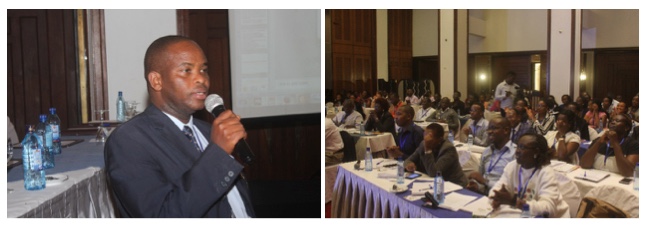
Prof. Mutui giving a presentation on safety of genetically modified organisms
European Labelling approaches for pre-packaged foods

Dr. Bryne giving informative presentations at the symposium
This topic was geared towards educating participants on how other countries work to promote consumer education and selection of packaged foods and was presented by Dr. Pamela Bryne- Chief Executive Officer, Food Safety Authority of Ireland (FSAI). In her remarks, she pointed out that labelling is mandatory as in General Food Law. It is the basis for making informed choices for consumers and protects consumers from fraudulent adulteration or being misled. Labels should be clear, legible and easy to understand, written in English and should not mislead the consumer. They should include name of product, list of ingredients, and origin of ingredients. Allergen information must be distinguished- in bold e.g. containing- wheat, soya, peanuts. Nutrition declaration on the labels must be present and in a particular order as is highlighted in the labelling requirements. Dr. Bryne also stressed on the importance of Traceability systems and encouraged delegates to visit the EU commission website which has all the information on labelling. Ireland has effective customer complain call centre where thousands of calls are received yearly.
Emerging Issues in Food Borne diseases
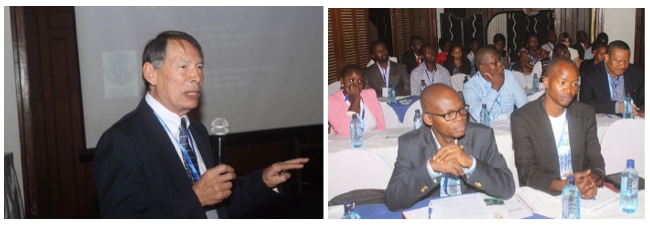
Dr. Moy giving informative presentations at the symposium
Dr. Gerald Moy, a Retired Senior Food Safety Scientist with WHO and currently the IUFoST food safety committee co-chair spoke on emerging issues in food borne diseases. According to the 2015 WHO global report on food borne diseases the most frequent diseases are diarrhea, Norovirus, Campylobacter and Salmonella. Generally there are 31 foodborne disease vectors-11 diarrheal disease agents, 7 bacterial, 3 protozoans, 7 invasive diseases, 3 chemicals. He elaborated that in 2010, 33 million people were affected by food borne illnesses whereby a DALYs (Disability Adjusted Life years) tool was used to analyze incidences, mortality and disease burden. Dr. Moy also highlighted other causes of food borne disease which include mycotoxins known to cause stunting in children, fetal and neonate toxicities and effects on immunity and gut and allergens.
He indicated that four approaches for intervention would be dietary diversity, Guidance on emergencies, Packaging interventions, sorting out of e.g. mycotoxin infested peanuts and Nixtamalization in reducing Aflatoxin in maize among other things. Dr. Moy also spoke on the use of approved antibiotics in order to reduce microbial resistance. One Health Initiative- WHO/FAO/OIE- has library and monitoring tools for the Antimicrobial Resistance Initiative. In addition to this there are new microbiology methods such as whole genome sequencing which gives results of microbial analysis within 12-24 hours. This has gone a long way in improving disease epidemiology that caters for the Need to have rapid and cheap diagnosis for investigation and surveillance. Also trending is the Global Microbial Identifier (GMI) for real-time disease surveillance. This is a database for microbes that will help in disease outbreak control through faster identification of causative agents.
Contribution of African Higher Education to Food Safety
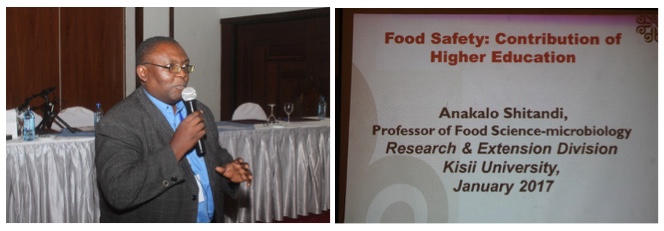
Prof. Anakalo giving a talk on food safety and higher education
Prof. Anakalo Shitandi spoke on the role of the Universities in assuring Food Safety. He noted that currently there are 14 out of 70 universities offering Food Science and related courses in Kenya alone. Out of these, only 3 are offering research and outreach hence the need for more. He asserted that the university plays a major role in food safety by making contributions on government advisory boards, consumer advisory, professional advisory committees, scientific societies, academia, manufacturers, observers, research and publication, capacity enhancement and food standards development. Universities are also actively involved in Food safety research emerging issues such as toxigenomics, microbiology, immunology, epidemiology and bio-informantics. This is enhanced by donors such as USAID and World Bank funding food safety research through improvement of specialized labs in the universities. The Universities also on their own accord have initiatives such as research on pesticides, antimicrobial resistance, extension and outreach to educate and create awareness on issues affecting the immediate community e.g. adulteration of milk using antibiotics. Dr Anakalo ended by recommending more education to be offered on GAP, GMP, HACCP, GHP, Global collaboration and participation at the University level.
The role of Kenya Bureau of Standards in assuring Food safety and quality in Kenya
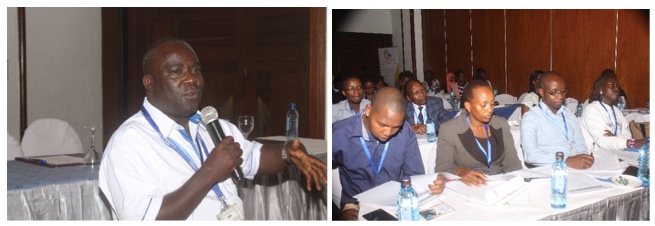
Mr. Samuel Onjolo of Kenya Bureau of Standards giving his presentation
Mr. Samuel Onjolo of Kenya Bureau of Standards (KEBS) wrapped the presentations through elaborate presentation on the critical role of KEBS in Kenya. KEBS is the regulator for all foods in Kenya and is in charge of standards development through technical Committees that include regulators, civil society, manufactures, research organizations, consumer organizations, academic institutions and interested parties.They are also charged with the responsibility of law enforcement through surveillance, customer complaints handling through Hotline/ Text message (few calls because of low consumer awareness), liaison and linkage between public and private sector. KEBS is also involved in Public participation through quality marks such as the most common S MARK (Standard Mark), ISM and the Diamond Mark of quality.
Outcome of group discussions: break-out sessions

In the afternoon session participants were divided into 9 groups where they discussed and presented on emerging issues in food safety in Africa. In the second break out session the groups were able to discuss and present the key areas of interest and major courses that would be necessary for a global Food Safety and Quality curriculum right from Undergraduate level to masters level. This section gives outcome of group discussions: Session one gives top ten issues raised by groups and gaps to be filled while session two gives discussions on curriculum.

Group presenters: Mr. Oloo, Mr. Musita and Mr. Njenga
Group 1: Food Losses
Session 1
1. Improper post-harvest handling causes food losses.
2. Damage during transport
3. Pests at farm level. Causes yield losses
4. Environmental and climatic changes- Heat, rain, humidity, temperature
5. Crop diseases
6. Field sanitation practices
7. Late harvesting- Over mature/ over ripe produce
8. Use of inappropriate harvest technology that injures the produce e.g. throwing stones on fruits
9. Storage fungi attacks
10. Chemical misuse and overuse resulting in excessive residues
11. Spillage and excessive peeling during processing
12. Improper preservation that leads to losses during storage. Poor storage conditions
13. At consumption, approximately 25% of the food is left on the plate. Is it fashion?
Gaps in Knowledge
1. Inadequate skills for processing
2. Inadequate understanding of food safety
3. Keeping abreast with technological advancements
4. Facilities and resources (technology/capacity)
5. Best practices on chemical use
Session 2: Food Safety Curriculum
Undergraduate Courses
1. Statistics/ Surveillance and Epidemiology
2. Chemisry/Agric-Practicum, industry/Farm to fork
3. Food presentation ]Policy and legislation
4. Risk analysis
5. Journalism/Communication
Practicum
1. Attach students across the farm to fork chain at all levels to gain general understanding of food safety issues.
2. Attachments in 2 phases- In first and second year and also in third and fourth year.
Masters Courses
1. Communication and Journalism
2. Job shadowing and apprenticeship
3. Regulations/policy
4. Quality assurance and safety of street and traditional foods.
5. Modelling statistics/epidemiology
GROUP 2
Session 1: Issues and areas where science and communication and interaction need strengthening for food safety
1. Language Barrier
2. Lack of integrity – corruption, adulteration of products, wrong labeling, not adhering to regulations
3. Inadequate funding/ Limited access to funds- Limits research and outreach
4. Lack of awareness on food safety by consumers/ Minimal knowledge- Some consumers have no idea how safety and food affect their health
5. Poor dissemination of knowledge/information- Not well disseminated to the masses, information is released in workshops and symposiums instead.
6. Low capacity in utilization of available knowledge- Data may be available but how does it reach to the farmer in the village?
7. Many sources of uncoordinated information- Poor collaboration amongst the media platforms
8. Poor policies that do not create good environment for food safety. Poor focus on food safety
9. Culture, People may not be ready to break away from some traditional practices that may predispose to food safety hazards.
10. Poverty-Leaves people with minimal choice for food so they consume whatever is available regardless of its safety.
How to close the knowledge gaps/ interventions
1. Diversification of food (Promote/Educate consumers)
2. Develop curriculum that is tailored at all levels; as early as primary school.
3. Budget allocation- Governments to increase budget allocation to funding for research and outreach
4. Educate the masses on credible sources of information
5. Collaboration among food safety organizations and institutions to communicate with one voice
6. Develop policies specifically targeting food safety
7. Involve media in food safety issues so that they communicate the right information.
8. Extension services.
Session 2: Food Safety Curriculum
1. Risk assessment and analysis
2. Crop production and protection
3. Agronomy:
a) Hydroclimatic conditions e.g. climate change
b) Water quality for food production
c) Soil health and quality
4. Multidisciplinary approach to teaching for the trainees to have a holistic perspective in food safety management
5. Training in good practices along the food supply chain i.e GMP, GAP, GHP, GLP.
6. HACCP/QMS
7. Importance of nutrition and safety in food security
8. Infrastructural development in laboratory and computing. Consistent lab training
9. Longer industrial attachment period to enable trainees to acquire adequate knowledge in food safety
Food safety Leadership program
1. Communication skills to enable them to deliver effectively
2. Risk analysis in determining the safety of the food and its practical application
3. Food Safety Management systems.
Group 3
Session 1: Traditional Foods
Top 10 key issues
1. Input levels. These include primary inputs such as herbicides and fertilizers
a) Poor quality inputs such as seeds which are not viable, lack disease resistance, wrong active ingredients in synthetic inputs, among other quality issues.
b) Presence of uncertified inputs in the market. These products do not have adequate information on usage, dosage, effects on eco system etc.
2. Farmers-primary producer level
a) Lack of adequate knowledge by farmers on proper use of inputs.
b) Unethical behavior and practices
c) Poor handling both pre and post-harvest. Can results from limited knowledge.
3. Losses and spoilage due to poor handling
4. Lack of adequate market for fresh indigenous vegetables. This means produce spoils while still at the farm or produce of poor quality reach the consumer.
5. Transport: Poor infrastructure e.g. Lack of cold chain systems, poor roads, inappropriate packaging and preservation.
6. Limited knowledge on food safety and handling among transporters.
7. Lack of proper facilities for processing, preservation and storage.
8. Fluctuation in quality of these veggies means that processed products cannot be consistent with regards to quality and safety.
9. Seasonal variations in quality. Processors lack adequate capacity to address safety issues associated with these fluctuations
10. Lack of proper knowledge on value addition means low consumption patterns of traditional foods. Hence a mismatch between supply and demand
The gaps identified
1. Knowledge and awareness on value addition, processing and nutritive value
2. Need to value add during processing rather than consuming is or as minimally processed products
3. Lack of proper infrastructure and processing facilities
4. Marketing and seasonal variations
5. Lack of proper guidelines and regulations to steer the sector
How to close the gaps
1. Provision of training and extension to build capacity of farmers, processors, transporters and traders
2. Initiate innovative technologies for handling and preservation
3. Acquisition of credit facilities to improve access to finance by different actors
4. Formation of regulations to guide sector
5. Create awareness among consumers about safe use, processing and cooking to address safety and quality concerns
Session 2: Food Safety Curriculum
Key Units
1. Food toxicology
2. Food hygiene and sanitation
3. Food microbiology
4. HACCP and PRP’s
5. GAP- Food preservation techniques
6. Food legislation and law
7. Food standards and trade
8. Market surveillance
9. Food analysis and sensory evaluation
10. Food quality assurance and quality control
11. Principles of biotechnology and enzymology
12. Food packaging and storage
13. Public health
14. Human nutrition
15. Crop and animal production and food safety
16. Benchmarking and exchange programs
17. Adequate lab practice for hands on experience
18. Prolonged internships-6 months
Masters Level
1. Public health
2. Food safety and leadership- social sciences and legislation

Group presentations: Ms. Loretta, Ms. Daisy and Ms. Regina
Group 4:
Session 1: Food Laws and Regulations-Implementation
Top 10 key issues
1. Corruption- bribery of officials to endorse products that do not comply with the laws.
2. Food laws do not cascade down to the consumers hence the consumer does not know what to demand and expect when it comes to food safety and quality
3. Fragmentation of the existing laws weakens the system and bring about duplication of roles, overlaps and gaps. Also results in complexity during implementation
4. Political interference. This ties the regulators from doing their job e.g. closing down a food factory that does not comply.
5. Lack of a national food safety policy which would serve as a guideline for implementation
6. Outdated food laws
7. Lack of understanding of the laws- Language may be too technical
8. We are more keen on food security at the expense of food safety hence the laxity in implementation
9. Political instability as a results of war, drought or floods which brings about food insecurity.
10. Inconsistencies in policy implementation due to the separation of roles
11. The gaps identified
1. Language used- too technical
2. Lack of outreach programs that would create awareness across the food supply chain
3. Inadequate training and specialization in Food safety which would create a work force that is expert in food laws and regulations
4. Inadequate consumer education
5. Inadequate training resources
How to close the gaps identified
1. Create outreach programs
2. Introduction of food laws and regulations at an early stage in education
3. Simplification of the language used in the laws
4. Advocacy for food policy formulation
5. Revision of outdated laws
6. Specialized training in food safety
Session 2: Food Safety Curriculum
Year 1:
Introduction to food science, Zoology, Human anatomy, Crop protection, Chemistry, Physics, Mathematics
Year 2:
Microbiology, Toxicology, Crop and animal production and food safety, Basic human nutrition, Food chemistry, Diet and diseases, Food laws and regulations
Year 3:
Food quality assurance, Food safety management systems, Risk assessment, Community participation and outreach
Year 4:
Post-harvest handling, GAP, GMP, GHP, GLP, HACCP, Food processing, field work and internship-6 months
Food safety and Leadership:
1. Communication skills
2. Public speaking
3. Participation in food safety conferences and forums such as the CODEX meetings
Group 5
Session 1: Food and nutrition
Top 10 issues:
1. Nutrition security- Availability and accessibility to safe, sound, nutritious food
2. Health- Unawareness, myths and misconceptions
3. Food safety
4. Food diversification
5. Over consumption of particular foods- intoxication
Interventions to the gaps
1. Nutrition education - outreach programs
2. Creating awareness – Media
3. Conducting food consumption surveys to check feeding patterns
4. Food fortification to cater for nutrition needs not met by processed foods e.g. maize meal.
5. Government interventions – Standards and Acts
Session 2: Food Safety Curriculum
Specific training to include
1. Infrastructure- Constant monitoring and evaluation of food transport, processing chain, regular supply of electricity and equipment maintenance
2. Agro climatic conditions and proper hazard detection principles to be incorporated (filtration analysis), Food spoilage and preservation methods.
3. Available technology:
a) Whole genome sequencing
b) Adopt GMO as a medicinal Technology
c) GMP and GAP awareness
d) Reinforce consequences of food fraud and adulteration
e) Collaborative inter territorial linking to food safety regulatory bodies and standards
f) Apprenticeship on market surveillance
4. Necessary practical/lab training in food safety
a) 6 months industrial training an attachment
b) Practical training programs concurrent to theoretical teaching
c) Technically certify and equip food labs
d) Periodically revise the set curriculum
e) Advocate and ensure training is undertaken in well-equipped labs/institutions
Master Level
1. Reinstitute, reinforce food safety programs from low levels of training to foster understanding
2. Constant screening, reassessment on the eligibility, authenticity of our leadership to conformity with emerging issues in the society today.
3. Gender sensitivity in food safety managerial responsibilities
Group 6:
Session 1: Contamination and Hygiene
Top 10 issues:
1. Identify contributing factors of contamination
2. Knowledge of standards governing contamination e.g. what constitutes a contaminated product and what are the maximum allowable limits
3. Lack of awareness
4. Resistance of individuals to conform to regulation (especially with behavioral change)
5. Lack of enforcement of rules and regulations due to weak institutions; also relates to corruption and bribery
6. Illiteracy- creates inability to understand or gain knowledge. This is consumer aspect
7. Lack of knowledge by consumer
8. Rationalization- consuming food despite knowing that it is contaminated
9. Poverty or poor living standards create an environment which is prone to contamination
10. Lack of GAP’s, GMP’s, GHP’s and suitable storage practices.
11. Post processing contamination e.g placement in stores whereby products get contaminated e.g by allergens.
Identified gaps
1. Illiteracy- barriers to communication to consumers
2. Resistance to change
3. Manufacturers are aware of rules but do not implement them due to cost implication
4. Lack of coordination between key players in the industry
5. Multi agencies that have different policies to comply to
6. Misinformation by erroneous sources
7. Lack of adequate information to the consumers
How to close gaps
1. Manufacturers and government to communicate better with consumers
2. Have media publish information from reliable sources for example by translating information into lay terms that can be universally understood.
3. Implement training to farmers, food handlers, consumers (Train individuals and all stakeholders and stakeholders to become experts
Session 2: food safety curriculum
1. Data collection and analysis
2. Microbiology-Food and applied industrial microbiology
3. Food quality assurance
4. Food preservation techniques
5. Statistical processing control
6. Research skills e.g. scientific methods and experimental design
7. Toxicology
8. Basics such as: Communication skills, Biochemistry, Organic chemistry, Inorganic chemistry, Health and diseases
9. Food engineering
10. Food legislation
11. Entrepreneurship
12. Biology
13. Food chemistry
14. Food processing
15. Analytical food techniques
16. Business management
17. Food extension education
18. Food hygiene and sanitation

Group presentations: Ms. Lois, Ms. Caroline and Wameyo
Group 7:
Session 1: Food Security and sustainability
Top Issues
1. Availability – Limited by climate change, Political instability, poor infrastructure, post-harvest process losses due to inadequate technologies, agricultural practices, Labor issues-aged and diseased farming community.
2. Ability to purchase – Long supply chain, farm gate vs market prices differ greatly due to middlemen.
3. Low per capita income
4. Condemnation of unsafe food material
5. Burden of disease
Gaps
1. Dissemination of research findings
2. Inadequate extension services
3. Information Education communication (IEC) materials
Steps to close the gaps
1. Strengthen extension services, funding and capacity building
2. Have farmer groups/co-operatives to close marketing gap
3. Collaborative public – private partnerships (ppp)

Group presentations: Dr. Mulwa, Mr. Moses and Mr. Zaccheus
Session 2: Food Safety Curriculum
BSC Program
1. Food Microbiology
2. Food Chemistry
3. Food process engineering
4. Food technologies
5. Food preservation
6. Post-harvest handling, storage and food security
7. Food storage pests
8. Human nutrition
9. Food spoilage and contamination
10. Principles of GAP
11. Food legislation, laws and enforcement processes
12. Food-borne diseases and allergens
13. Epidemiology and surveillance
14. Research methods
15. Biotechnology and bioinformatics
16. Statistics
17. Community service and extension training
MSC program
1. Research methodology and thesis
2. Research planning management
3. Quality and safety audits
4. Risk analysis and management toxicology
5. Food safety management tools
6. Food safety and quality standards
7. Institutional collaborations and international student exchange
8. Food policy formulation
9. Biostatistics
10. Biotechnology
11. Environmental health, sanitation and laws
12. Leadership and advocacy
13. Innovative design of storage structures
Internship/practical
1. 10 months industrial internship
2. Report writing
3. Presentation skills
4. Computer skills
5. Data analysis – statistical
6. Leadership and decision making
7. International student exchange program, also with regional and international food legislation bodies
8. Thesis- 1 year with regional perspective
9. Scholarship positions
Group 8
Session 1: Food safety and the role of the consumer/Consumer responsibility
Top Issues
1. Those who are supposed to be informing the consumers, lack adequate knowledge for this
2. A lot of food-borne issues arising in the catering sector and the informal foods sector
3. Quality of water being used to grow food is highly contaminated leading to myriad of food safety concerns
4. Lack of proper regulation in the food sector such that anybody can produce regardless of their understanding of food safety and hygiene
5. Ignorance of the consumer as pertains to food safety
6. Fragmentation within the system such that it is not clear who should be doing what so nothing is done sometimes
7. Lack of absorption of trained food scientist in government agencies responsible for regulation
8. Improper storage of already processed products by the retailers and distributors. Some sell expired product to unaware consumers
9. Lack of awareness of consumer responsibility in the supply chain
Gaps identified
1. Consumer is not aware of their rights
2. Evidence barred policy making involving all the key players
3. Accurate and current data on the extent of several food safety issues is lacking so documents being passed do not capture the actual extent of the problem
Steps to close the gaps
1. Consumers should be properly informed or joined by those with the expertise in research and academia. Integrating consumer groups with those who have the information.
2. Basic education of the consumer on food hygiene, depending on the type of food it is, whether processed or raw. Empower consumer to understand and practice their role.
3. Advocacy groups- Putting retailers to task to ensure proper storage and sale of processed products
4. Consumers should be empowered and pathways made easy for them to complain about poor retailers
5. Involvement of the consumer in making policies and standards. Come up with clear ways to empower them to participate
6. Employment of qualified scientists in all the sectors of the food and water both at national and county government level to ensure that proper procedures and steps are taken.
7. Use of radio and TV to reach out. Advantage of radio and TV broadcasted in many different local languages
8. Extensive use of social media for advocacy
Session 2: Food Safety Curriculum
*Missing notes
Group 9
Session 1: Scientific communication Vehicles
*Missing notes
Session 2: Food Safety Curriculum
Specific areas of training-BSC
1. Food microbiology
2. Food toxicology
3. Food standards: National and international
4. Food laws and regulations
5. General communication
6. Quality control and assurance systems
7. Ethics in food safety management
8. Hazards in food
Graduate level
1. Policy formulation and implementation
2. Standards development process
3. Legislation of food laws
4. Quality management
5. Research methods
6. Epidemiology and surveillance
7. Scientific communication and outreach
8. Economics and food safety
9. Risk analysis and communication
Practical/Lab training
1. Food analysis
2. Microbial analysis
3. Audit systems
4. Recalls and withdrawals
5. Involvement in legislation process
Selected photos from the symposium
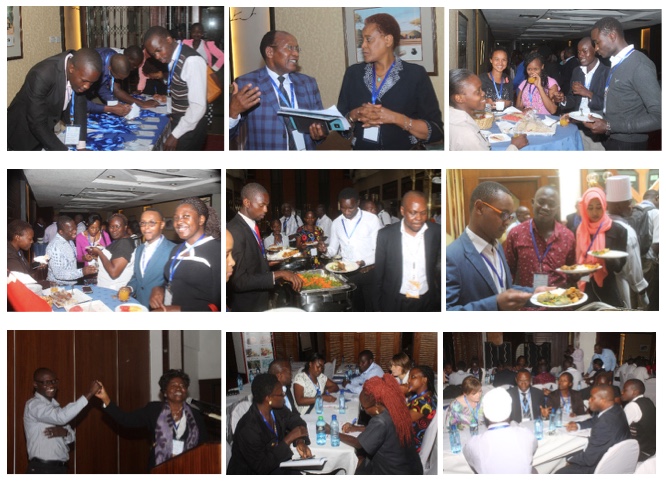
IUFoST Scientific Information Bulletin (SIB)
FOOD FRAUD PREVENTION